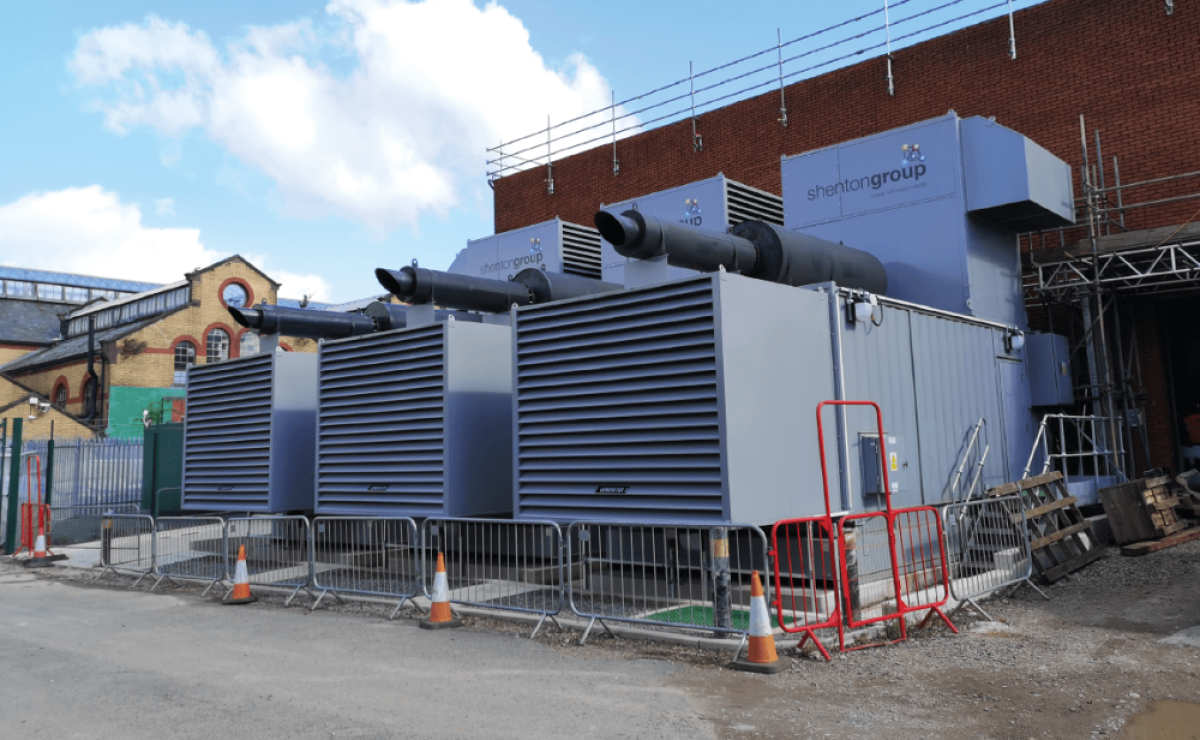Client: Welsh Water Pumping Station
Sector: Utilities
Location: Cardiff, Wales
Products/ Services
- Design services
- 3 No. 1.25 MVA prime rated generators in N+1 configuration in 75 @ 1m acoustic enclosure
- 3 No. 7500 litre slab tanks
- WIMES (Water Industry Mechanical & Electrical Specifications) compliant
- Commissioning services
- Maintenance contract
- Turnkey project
Background
Cardiff Pumping Station needed to upgrade its power supply and replace its four existing 46-year-old Blackstone generators that support their water flow pumps. The existing generators were no longer fit for purpose, as they could not support load sharing and didn’t synchronise.
Cardiff Pumping Station is a combined station that passes through 500 – 1200 litres of water per second on a dry day, known as ‘normal dry weather flows’. However, in storm conditions, this could increase by 3-6 times.
Shenton Group were one of three generator suppliers approached by Arup on behalf of Welsh Water to assist with the initial designs and feasibility. Along with offering a turnkey project where we would also remove the old equipment, the design we put forward negated the need for rental generators and reduced the amount of cable, which would save the client a quarter of a million pounds. This ultimately leads us to win the project.
Project Overview
COVID19 travel restrictions were put in place one week before the Factory Acceptance Test (FAT) that was to take place at Shenton Group’s HQ in Andover, Hampshire. However, the FAT was successfully conducted live, online, via Microsoft Teams to ensure no delays. It was noted by Morgan Sindall and Welsh Water the level of effort and care taken by Shenton Group staff throughout the FAT to deliver peace of mind.
Shenton Group supplied and installed three 1400kVA standby rated generators using MTU engines and a ComAp control system. Due to the site proximity to public areas, we could not exceed a noise level requirement of 75dB(A) @ 1 metre. To enable this, we designed bespoke acoustic containers utilising the ‘penthouse’ air inlet arrangement to ensure that the overall footprint was kept to a minimum and the installation could fit within the footprint we had on site. As part of the specification of the acoustic container, the final paint finish needed to be C3M compliant, and the doors and frames needed to be SR3 rated. We also housed the generator switchgear within each acoustic container consisting of the neutral earth contactor, generator output breaker, and load bank connection breaker. The interconnecting cables between the alternator and the switchgear were installed by ourselves as well as the cabling between the switchgear and the external cable connection boxes located on the side of the containers.

We also looked after the complete fit-out of lighting and heating within the enclosure and the distribution boards for the small power requirements. With a varying load on site, it was important that the generators could respond quickly to changes whilst also being configured to offer resilience. To enable this, the three generators were set up to synchronise set to set, allowing them to load share whilst also having the capacity to offer redundancy should one fail. All elements of the synchronising design and control programming was carried out in house and demonstrated at the factory acceptance test.
Due to limited space on site, thought was needed to be given as to how the required amount of bulk fuel storage could be achieved. To overcome this challenge, we designed bespoke bulk’ slab tanks’ to sit underneath each generator and hold the required 15,000 litres of fuel per tank. To offer further redundancy, all 3 of the slab tanks had a balance line enabling fuel to be shared between any of the generators should it be required, and each tank was fitted with its own fuel polishing system. Whilst not part of our package, we liaised closely with Morgan Sindall to ensure the concrete base was built to a suitable specification and that all weights, point loadings and cable ducting routes had been allowed for. Once the installation was complete, it then went through a final rigorous testing phase to demonstrate the entire working system and synchronisation.
The new generators were installed just outside the building where the existing generators were located. This enabled us to upgrade the site with minimal risk and disruption, ensuring the station remained with power throughout the upgrade.
Further works consisted of removing the existing generators from site, striping and de-commissioning the existing fuel system, and transporting them to the Anson Engine Museum to be preserved as part of engineering history.


With the support of Wildon LTD, custom ‘draw like’ rollers were created to roll the existing generators out of the building. This method reduced the number of crane lifts and enabled the generators to be removed without being dismantled. There was no guaranteeing that if the 46-year-old machinery would go back together again if it was dismantled. A dedicated Shenton Group project manager oversaw all project elements, from contract award to commissioning.
Outcome

Thanks to the early engagement at the design phase, Shenton Group were able to re-design a solution that would save the client a quarter of a million pounds off of the whole project. The client’s power supplies are now fully upgraded to meet the demands of the site. The client also opted for a Shenton Group maintenance contract to further ensure reliability.
It was sentimentally sad to see the generators go, but I am glad that they have gone to an engine museum. I like the way that Shenton Group have managed and delivered the whole project.
Rob Sansom – Welsh Water
Senior Carft Electrical
Senior Authorised Person High Voltage

